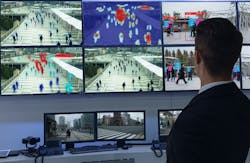Do open architecture systems inhibit advanced analytics?
I was recently in a restaurant with colleagues for a quick bite and noticed something a bit odd on the menu that caught my attention. Under the salad section, it stated “Caesar Salad without Chicken,” which prompted me to ask, “What else can I get this salad without?” Initially intended as my feeble shot at comedy, I started to think about how relevant this absurdity is to the current state of the video management system (VMS) marketplace.
If you were to conduct an exhaustive comparison of today’s leading VMS solutions, the truth is that they pretty much offer many of the same management and control functionality. Although called different things in an attempt to differentiate them from the field of competitors, almost every VMS solution seems to offer various configuration options that are scalable to accommodate an infinite number of cameras, provide some form of failover recording redundancy, incorporate several layers of security and encryption, and more.
But there is one VMS feature attribute that is almost always mentioned front and center using the same specific nomenclature: open architecture. In fact, many VMS systems on the market today are engineered on an open architecture platform. Aside from allowing smoother integration with various third-party hardware and software, like access control and POS, for example, open architecture VMS software also enables these systems to incorporate third-party analytics. This is the key to providing surveillance-based solutions for more advanced enterprise-level deployments that often transcend traditional security applications to include business intelligence. This is obviously a good sales and marketing attribute for VMS suppliers to promote to help increase their share of the security market, and to position themselves for more advanced business intelligence deployments moving forward.
Neural Networks and Native Analytics
However, every perspective has its reciprocal. Looking at an open architecture platform from another viewpoint, conventional VMS systems are available without many things, just like “Caesar Salad without Chicken.” This too is for good reason. To effectively embed intelligent analytics into a VMS solution, the software’s basic architecture needs to be constructed differently, which precludes most VMS suppliers from offering advanced organically developed analytics.
The reality is that an open architecture platform simply doesn’t provide the necessary computational power to effectively develop advanced analytics with new levels of Artificial Intelligence (AI) that can be seamlessly embedded into a host VMS solution. The framework for these new AI-powered analytics is largely dependent on the development of Artificial Neural Networks (ANN).
VMS solutions with ANN enable many different machine learning algorithms to work together to process very complex operations, including operations that we now commonly refer to as delivering some degree of AI. ANN empowers software and embedded devices with the ability to perform various tasks and operations by considering different documented behaviors as examples for comparison. This is, and should be, the new key differentiator for VMS solutions, separating them into one of two distinct categories of “the haves” and “the have nots.”
VMS platforms with ANN that employ organically developed and embedded image recognition-based analytics can learn to identify myriad objects. A good example is the ability to identify vehicle types which is accomplished by analyzing hundreds or thousands of images of various trucks, cars, and busses that have been identified and labeled, and then assigned to one identified vehicle category. When a camera detects a vehicle, the system compares the new image with the stored examples of all vehicle images in its database. Then the analytics software decides as to which category best describes the vehicle, even if no exact match has been seen before.
The development of advanced VMS solutions with ANN is driving a paradigm shift in security professionals’ expectations as to the potential performance capabilities of today’s more advanced video surveillance systems. Whereas video surveillance was once relegated for real-time surveillance and forensic investigations, advanced VMS solutions built on ANN and organically developed analytics with AI capabilities enable new levels of predictive analysis, placing prevention high on end-users’ list of expectations. This mindset changes everything, greatly influencing the development of new software and hardware solutions, and further incentivizing product and software engineers to accelerate development processes.
The truth is that VMS platforms with ANN that employ various embedded intelligent analytics – such as license plate recognition, facial recognition, speed and movement detection, under vehicle inspection, traffic violations, and situational awareness – are increasingly finding their way into more installations with the help of experienced systems integrators. And we can expect this trend to continue, as the required time and effort for deployment, and the overall costs of implementing a highly intelligent VMS solution with native analytics continues to decrease versus conventional VMS solutions integrated with third-party analytics.
The physical security industry is clearly undergoing virtualization with a shift from hardware to software-based solutions that deliver higher levels of intelligence. Advanced VMS platforms that are built on ANN and employ organically developed analytics capable of integrating with enterprise level systems and big data provide the roadmap for physical security solutions with even more powerful capabilities than we see today. And this is just the beginning… “Caesar Salad with Everything” will be added to the menu soon.
About the Author:
Aluisio Figueiredo is the CEO of Intelligent Security Systems.



